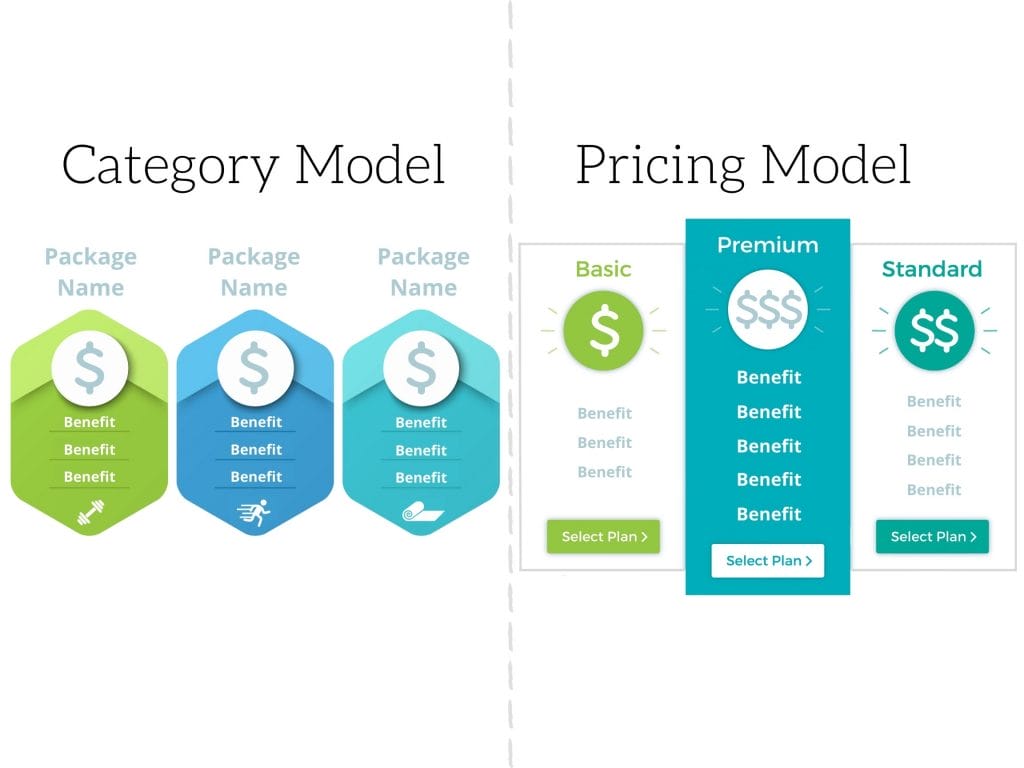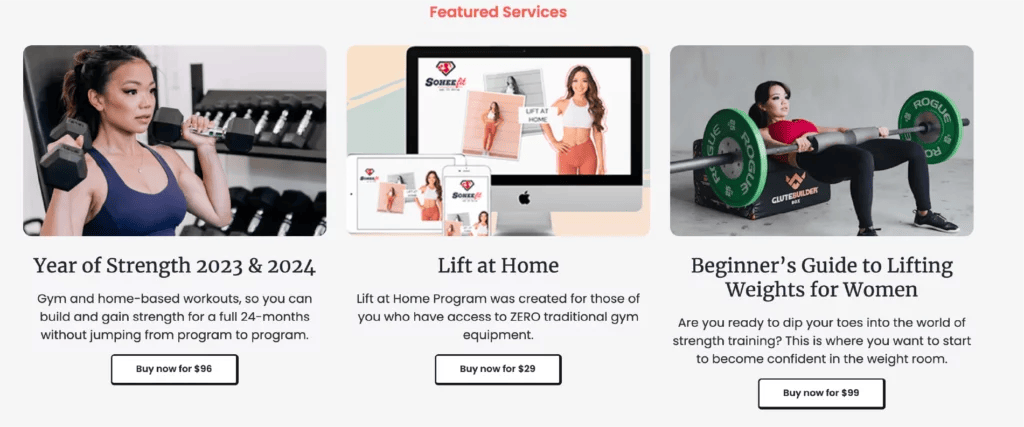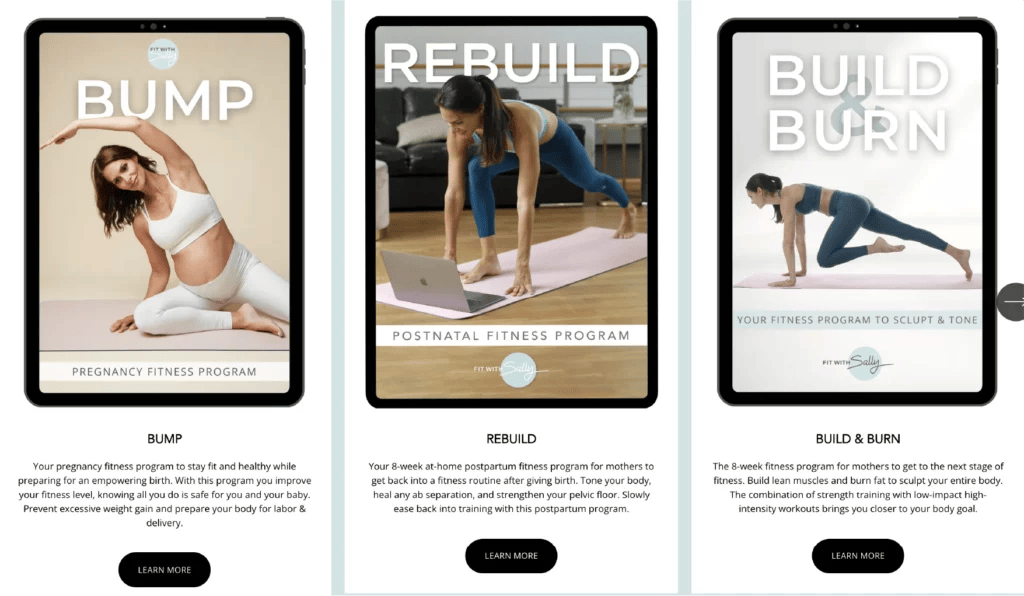- Last Updated:
- 1/14/2025
- Chelsea Ramsey, ACE CPT
Online personal training packages give you the ability to broaden both your reach and offerings as a personal trainer. Instead of limiting your schedule to only one-on-one sessions, you can work with multiple clients simultaneously, which in turn can help you grow your business and make more money.
To create online training packages decide on:
- Package model(s) – time-based, features-based, etc.
- Training services – goal setting, workout planning, nutrition consulting, others
- Training formats – hybrid online and in-person, 1:1 live virtual meetings, pre-recorded videos, shared Google docs, etc.
- Competitive and reasonable pricing
- Branding and marketing
- Ongoing adjustments and improvements based on feedback
Ready to get started? See examples of virtual training packages, learn how to build them, get ideas for your business, and download free templates to make it all easier.
What Are Online Personal Trainer Packages?
A training package is a comprehensive plan or program you offer to clients for a specific fee. Each package includes a set of tools, resources, and information to help clients reach a certain goal.
It’s a good idea to start off with a few base options, with the ability to add to your package catalogue as you grow.
Packages can be presented in a variety of formats.
- PDFs
- Shared Google sheets
- Videos
- Gated websites
- Fitness client management software
- A combination of videos, files, software, or other media
Personal Training Package Examples
There are two basic types of training packages. Some of the most popular package models are category/goal-structured, while others are tiered based on price, value, or time commitment.

Price and Value Tiered-Fitness Packages
Price tiered-packages are generally structured in some type of standard, standard plus, and premium format. Higher priced tiers provide more support, individual attention, and/or customization for the client vs. less-costly lower tiers.
A real-world tiered-pricing model:

Category and Goal Models
Category models are structured around achieving a specific goal, addressing a specific issue, or focusing on a particular modality like strength training or marathon prep.
Some real-world examples:


Duration and Time-Based Models
Time-based training packages specify the time commitment required to complete them. They may have a promised end goal or a general overall fitness benefit.
You can advertise these types of plans as:
- Based on the participant’s starting fitness level
- A more intense, accelerated program
- Goal-focused
Features and Benefits
Don’t forget to call out both the features and the benefits clients will experience during and after completing your training program. While benefits might be obvious to you, potential clients may not understand what an additional two weeks of training or two extra progress calls might get them.
Benefits to consider calling out include:
- Improved mood
- Better sleep
- Clothes fitting better
- Feeling stronger
- Feeling less hungry
- Establishing healthy habits
- Improved confidence
- Better muscle tone
- Increased strength
- And more!

Build Your Personalized Personal Trainer Packages
- Determine your target clientele and training style(s)
- Choose a package structure
- Identify package features
- Build your content
- Price your package
- Market your services
Determine Your Target Clientele and Training Style(s)
First, decide who the ideal client is for this package: age, background, goal, starting fitness level, etc.
Next, decide on the training styles or end goals this package focuses on: fat loss, strength training, flexibility, etc.
From here, you can choose a package structure, build in features, and create, price, and promote your online fitness training packages.
Choose a Package Structure
- Pay-per-session: clients pay per virtual session or buy a set of 1:1 sessions or workout plans
- Subscription: clients pay monthly, quarterly, etc. for access to you and your programming
- Goal-based: outcome-oriented (lose 10 pounds in 3 months, do your first pull-up in 8 weeks, etc.)
- Tiered: levels of similar packages (standard, premium, VIP or beginner, intermediate, advanced plans)
- Duration: the time frame the package covers if not otherwise specified
Choose a Package Structure
Features include all the things clients will receive or have access to when they purchase this training package.
Tools and features can include, but are not limited to:
- Customization
- Goal-setting
- Workout plans
- Workout tracking
- Nutrition guidance
- Habit tracking
- Direct messaging
- App usage
- Exercise video library
- Video calls/sessions
- Accountability check-ins
Build Your Content
Decide how you will distribute or provide the content promised in your program. Will everything be in an app, emailed, or via a pay-walled website? Make sure all the workout plans/templates are ready, videos are edited and uploaded, and all the other content is prepped for delivery.
Remember: each client is unique. While you can use workout templates as a base, some clients will also need modifications. If you’re not writing customized workouts for each client, make sure the preferred alternatives to each exercise are clearly identified or linked to.
Pro Tip: When building your packages, make sure you protect your business legally and professionally with personal trainer insurance. It’s also a good idea to include liability waivers and health questionnaires as part of your packages to reduce the risk of clients getting hurt or clients suing you if they do.
Price Your Package
When calculating prices, take into account:
- Market research: what do similar trainers charge?
- Your level of experience
- Your time commitment
- The client’s time commitment
- Value: what kind of value are clients getting from your expertise, support, etc.?
- Discounts: will you offer introductory discounts, seasonal promotions, or other incentives?
Market Your Packages
Promote your packages on your website, social media, direct mail, and other channels your target clients use. Remember to clearly outline the benefits, value, or impact of your program (what may seem obvious to you, might not be so obvious to potential clients!)
Learn more about marketing your fitness business.

How to Set Yourself Apart From Other Trainers
To stand out and build your brand, find a niche, develop a unique voice, build connections, and create a strong marketing strategy.
If you’ve researched careers in the fitness industry, you’re probably familiar with the concept of specializations. Providing a niche service or a unique approach to your training are some of the most effective ways to set yourself apart from the crowd.
A niche service can be any specialization you’re particularly knowledgeable or passionate about, or one that fits an underserved need:
- Pre- and post-natal fitness
- Pregnancy fitness
- Sports conditioning
- Triathlete training
- Yoga for beginners
- Fitness for those with chronic pain
- Yoga, strength training, or overall fitness for those with special needs
You can also utilize a unique approach to your training to help you stand out. Make your brand voice and messaging uniquely appealing to your ideal clients.
- Fun and lighthearted, with an emphasis on enjoyment
- Supportive, caring, and understanding
- Personal connections, your personal story about why you do the work you do
- Emphasis on the mind-body connection
- A “be-a-badass” motivational approach
How Much Do Online Personal Trainers Make?
According to salary calculators like ZipRecruiter and Indeed, online personal trainers can expect to make around the same as in-person trainers: about average $29–$30 per hour.
In-person training, however, has some limitations that virtual training does not. In-person trainer salaries are influenced by things like:
- Time (limited training slots per day)
- Local economy
- Regional competition for the client type and/or specialty
- Availability of in-person training locations
- Fitness facility fees and/or pricing models
Virtual trainers generally have more flexibility and control over both their time and their prices, which can work to their advantage. On the flip side, compared to gym or fitness center-employed trainers, they are also responsible for running and promoting their businesses.
Protecting Your Online Training
Whether coaching virtually or in person, accidents can happen any time. Even if you’re not present to actively monitor your online clients, you may still be held liable for injuries they sustain while performing a workout they purchased from you, or from advice you gave them.
Protect yourself, your small business, and its assets in the event of mishaps with personal trainer liability insurance from Insurance Canopy for $15 per month!
And with an online business, there’s also a greater risk of being hacked. Add cyber liability coverage to your policy for just $8.25 a month.
Learn more about becoming a successful online personal trainer in Part Five: Transitioning Clients To Virtual Training

FAQs About Online Fitness Coaching Packages
Can I Offer Both In-Person and Online Personal Training, and How Should I Price Them Differently?
Yes, you can offer in-person, online, or a combination of both methods of personal training. The main difference in pricing should reflect the amount of your time required. If you have to travel to the client, provide equipment, and correct techniques in person, for example, you should charge more than if you just provide them with a plan but not 1:1 supervision.
What Platforms or Tools Should I Use for Delivering Online Training?
Fitness trainer software apps can be a huge help to online personal trainers with multiple clients. They offer tools for scheduling, time management, billing/payments, and some even allow you to host videos and a variety of online training materials. You may also use:
- Your website
- Printable documents like PDFs or Google docs
- Zoom, FaceTime, Skype, or other video conferencing apps
What Should I Include in an Online Personal Training Package?
- A clear overview of the program
- Explicit instructions on how to perform each exercise and/or links to visual examples
- Alternatives or modifications for every exercise
- Ongoing support
- Contact information and parameters (like official business hours)
- Appropriate privacy statements
- Liability and/or consent waivers

Chelsea Ramsey, ACE CPT | Copywriter
Ohio-based copywriter and licensed insurance agent Chelsea Ramsey leverages her experiences as an American Council on Exercise (ACE) certified personal trainer, a role-playing game writer, and a former auto claims adjuster. She holds a bachelor’s in English from Ohio State University and a TEFL certification from Oxford Seminars. Before working at Veracity, Chelsea wrote for Zulily and trained clients at her local community center. She now writes to assist fitness professionals and entertainers in finding their ideal insurance policies.
Ohio-based copywriter and licensed insurance agent Chelsea Ramsey leverages her experiences as an American Council on Exercise (ACE) certified personal trainer, a role-playing game writer, and a former auto claims adjuster. She holds a bachelor’s in English from Ohio State University and a TEFL certification from Oxford Seminars. Before working at Veracity, Chelsea wrote for Zulily and trained clients at her local community center. She now writes to assist fitness professionals and entertainers in finding their ideal insurance policies.





